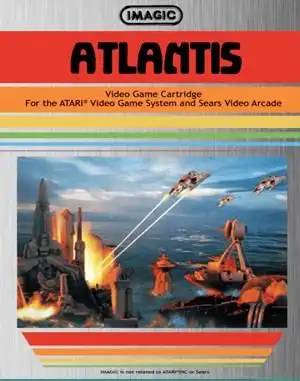Remember the thrill of defending an ancient underwater civilization with blocky laser beams? If you owned an Atari 2600 in the early 1980s, chances are you spent hours battling the relentless Gorgon fleet in Imagic's classic fixed shooter, Atlantis. It wasn't just another space invader clone; it had a unique setting, distinctive visuals, and that signature Imagic polish that made their cartridges stand out from the pack.
Let's take a nostalgic dive back into the depths and revisit what made Atlantis on the Atari 2600 such a memorable experience.
What Was Atlantis All About?
Released in 1982, Atlantis put players in charge of defending the mythical underwater city from an impending invasion by the mysterious Gorgon fleet. Developed and published by Imagic, a company founded by ex-Atari programmers known for pushing the 2600's graphical capabilities, Atlantis was a key title in their impressive library.
Unlike many shooters of the era that involved moving your ship, Atlantis was a fixed shooter, meaning your defensive posts were stationary. This simple premise, combined with challenging gameplay, quickly made it a favorite.
Defending the Underwater City: Gameplay Breakdown
The core objective in Atlantis is straightforward: stop the Gorgon ships from destroying the seven sectors of your city. You control three defensive posts: the central Acropolis Command Post and two sentry posts flanking it.
- Your Weapons: Each post fires a single, blocky laser beam upwards. The Acropolis fires a wider, slower shot, while the sentries fire faster, narrower beams.
- The Enemies: Gorgon ships descend from the top of the screen in waves. They vary in size and speed, with smaller, faster ships often being worth more points but harder to hit.
- Survival is Key: Your score isn't just about shooting enemies; you also get points for each sector of the city that survives a wave. If all seven sectors are destroyed, it's game over.
- Strategic Defense: While it seems simple, deciding which post to fire from and timing your shots against the different ship speeds adds a layer of strategy. The Acropolis is crucial as it powers the city's force field (in some modes), but its destruction is often the beginning of the end.
- Game Modes: Atlantis featured several variations, including options with a disabled Acropolis (upping the challenge significantly) and faster enemy speeds. There was even a two-player mode where each player controlled different defensive posts.
More Than Just Missile Command?
Many players compare Atlantis to Atari's arcade hit Missile Command, and the parallels are clear: defend structures from descending projectiles using fixed turrets. However, Atlantis had its own distinct feel. The underwater setting, the specific ship patterns, the visual feedback of hitting targets, and the different defensive posts gave it a unique identity. It wasn't just a clone; it was Imagic's take on the genre, executed with their trademark flair.
The Look and Sound of Imagic Magic
Imagic games were often lauded for their visual and audio design on the limited Atari 2600 hardware, and Atlantis was no exception.
- Graphics: The underwater city looked distinct, with colorful, recognizable structures. The Gorgon ships were varied and animated smoothly for the system. The explosions were satisfyingly blocky. It truly felt like a vibrant, albeit abstract, underwater world.
- Sound: The sound effects were simple but effective. The distinct sounds of your lasers firing, enemies exploding, and the ominous hum of the Gorgon ships created an immersive atmosphere that perfectly complemented the frantic action.
Was Atlantis a Hit?
Absolutely! Atlantis was a massive success for Imagic. It quickly became their second best-selling game, trailing only the ubiquitous Demon Attack. Millions of copies were sold across its various ports, cementing Imagic's reputation as a premier third-party developer for the Atari 2600 and other systems.
Its popularity even spawned a special, much harder version, Atlantis II, which was given as a prize to winners of a video game competition. This version featured faster enemies that gave fewer points, truly testing the skills of even the most seasoned players.
The game also received positive reviews at the time, praised for its original concept and impressive presentation on the 2600. It even earned a "Certificate of Merit" at the 1983 Arcade Awards.
Imagic's Legacy and the Fate of Atlantis
The game's ending sequence was particularly memorable. If you managed to hold out long enough, a small ship would launch from the city, carrying survivors to safety before Atlantis was finally destroyed. This ship was intended to be the Cosmic Ark from Rob Fulop's follow-up Imagic game, Cosmic Ark, hinting at a connected universe within Imagic's titles – a cool touch for the time!
Sadly, despite early success, Imagic eventually faced financial difficulties and closed its doors in 1986, a casualty of the wider video game market crash. However, their games, including Atlantis, live on in the memories of retro gamers.
Reliving the Defense: Playing Today
While finding an original Atari 2600 console and Atlantis cartridge is a fun part of retro collecting, you can easily experience this classic today through emulation. Projects like Stella (Atari 2600 emulator) paired with ROMs available from sites like the Internet Archive allow you to defend Atlantis right on your modern PC. There have also been fan remakes over the years, though nothing quite captures the feel of the original on the vintage hardware.
Frequently Asked Questions
Q: Who developed Atlantis for Atari 2600? A: Atlantis was developed and published by Imagic, a prominent third-party game company during the Atari 2600 era.
Q: Is Atlantis similar to Missile Command? A: Yes, it shares similarities as a fixed shooter where you defend structures from descending enemies, but Atlantis has its own unique underwater theme, defensive posts, and gameplay nuances.
Q: What is Atlantis II? A: Atlantis II was a special, harder version of the game created for a video game competition, featuring faster enemies and lower scoring to challenge expert players.
Q: Can I play Atlantis today? A: Yes, you can play Atlantis on modern computers using Atari 2600 emulators like Stella and game ROMs often found on preservation sites like the Internet Archive.
Conclusion
Atlantis for the Atari 2600 remains a shining example of Imagic's talent and the creative potential within the limitations of the 2600 hardware. Its unique theme, addictive fixed-shooter gameplay, and impressive presentation made it a standout title. For anyone who played it back in the day, or for those discovering it now, defending the beautiful underwater city from the Gorgon threat is a timeless piece of retro gaming history worth revisiting. Power up those sentry posts and prepare for the dive!


